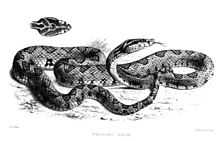Trimeresurus jerdonii
| Trimeresurus jerdonii | |
|---|---|
 | |
| T. jerdonii at the San Diego Zoo | |
| Scientific classification | |
| Kingdom: | Animalia |
| Phylum: | Chordata |
| Subphylum: | Vertebrata |
| Class: | Reptilia |
| Order: | Squamata |
| Suborder: | Serpentes |
| Family: | Viperidae |
| Subfamily: | Crotalinae |
| Genus: | Trimeresurus |
| Species: | T. jerdonii |
| Binomial name | |
| Trimeresurus jerdonii Günther, 1875 | |
 | |
| Synonyms | |
| |
Trimeresurus jerdonii is a venomous pit viper species endemic to India (Assam), Burma, Tibet, China and Vietnam. Three subspecies are currently recognized, including the nominate subspecies described here.[5]
Etymology
The specific name, jerdonii, is in honor of British herpetologist Thomas C. Jerdon who collected the type series.
Description
Males grow to a maximum total length of 835 mm (32.9 in), with a tail length of 140 mm (5.5 in); females to 990 mm (39 in), with a tail length of 160 mm (6.3 in).[6]
Scalation: dorsal scales in 21 longitudinal rows at midbody (rarely 23); snout length a little more than twice diameter of eye; head above, except for large internasals and supraoculars, covered by small, unequal, smooth scales that are feebly imbricate or juxtaposed; first labial completely separated from nasal scales by a suture; internasals separated by 1-2 small scales; 6-9 small scales in line between supraoculars; 7-8 upper labials, third and fourth beneath eye, in contact with subocular or separated by at most a single series of small scales; ventrals: males 164-188, females 167-193; subcaudals: males 50-78, females 44-76.[6]
Geographic range
Found from Assam in India, through northern Burma to Tibet, China (Hupeh, Szechwan, and Yunnan), and Vietnam. The type locality given by Günther is "Khassya" (=Khasi Hills, India).[1]
Subspecies
| Subspecies[5] | Taxon author[5] | Common name[3] | Geographic range[3] |
|---|---|---|---|
| T. j. bourreti | Klemmer, 1963 | Bourret's pitviper | Northwestern Vietnam (in the provinces of Lào Cai and Lai Châu, and possibly also in adjacent China (Yunnan). |
| T. j. jerdonii | Günther, 1875 | Jerdon's pitviper | Southwestern China (in the provinces of southern Xizang (Tibet), western Sichuan and Yunnan), northeastern India, Burma (Chin and Kachin state), and northeastern Nepal. |
| T. j. xanthomelas | Günther, 1889 | Red spotted pitviper | Central and southern China, in the provinces of Henan, Shaanxi, Gansu, Sichuan, Guizhou, Hubei and Guangxi. |
See also
- List of crotaline species and subspecies
- Trimeresurus by common name
- Trimeresurus by taxonomic synonyms
- Crotalinae by common name
- Crotalinae by taxonomic synonyms
- Snakebite
References
- ↑ 1.0 1.1 McDiarmid RW, Campbell JA, Touré T. 1999. Snake Species of the World: A Taxonomic and Geographic Reference, Volume 1. Herpetologists' League. 511 pp. ISBN 1-893777-00-6 (series). ISBN 1-893777-01-4 (volume).
- ↑ The Reptile Database. www.reptile-database.org
- ↑ 3.0 3.1 3.2 Gumprecht A, Tillack F, Orlov NL, Captain A, Ryabov S. 2004. Asian Pitvipers. GeitjeBooks. Berlin. 1st Edition. 368 pp. ISBN 3-937975-00-4.
- ↑ Brown JH. 1973. Toxicology and Pharmacology of Venoms from Poisonous Snakes. Springfield, Illinois: Charles C. Thomas. 184 pp. LCCCN 73-229. ISBN 0-398-02808-7.
- ↑ 5.0 5.1 5.2 "Trimeresurus jerdonii". Integrated Taxonomic Information System. Retrieved 25 May 2007.
- ↑ 6.0 6.1 Leviton AE, Wogan GOU, Koo MS, Zug GR, Lucas RS, Vindum JV. 2003. The Dangerously Venomous Snakes of Myanmar, Illustrated Checklist with Keys. Proc. Cal. Acad. Sci. 54 (24): 407-462.
Further reading
- Boulenger, G.A. 1890. The Fauna of British India, Including Ceylon and Burma. Reptilia and Batrachia. Secretary of State for India in Council. (Taylor and Francis, Printers.) London. xviii + 541 pp. (Trimeresurus jerdonii, pp. 427-428.)
- Günther, A. 1875. Second Report on Collections of Indian Reptiles obtained by the British Museum. Proc. Zool. Soc. London 1875: 224-234. (Trimeresurus jerdonii, pp. 233-234 + Plate XXXIV.)
External links
| Wikimedia Commons has media related to Trimeresurus jerdonii. |
- Protobothrops jerdonii at the Reptarium.cz Reptile Database. Accessed 6 December 2007.
- Protobothrops jerdoni, image 1/4 at Uetz Lab. Accessed 25 May, 2007.
- Protobothrops jerdoni, image 2/4 at Uetz Lab. Accessed 25 May, 2007.
- Protobothrops jerdoni, image 3/4 at Uetz Lab. Accessed 25 May, 2007.
- Protobothrops jerdoni, image 4/4 at Uetz Lab. Accessed 25 May, 2007.
- Video of various snakes, incl. Trimeresurus jerdonii on YouTube. Accessed 17 August, 2007.
- Video of T. jerdonii giving birth, part 1/2 on YouTube. Accessed 25 August, 2007.
- Video of T. jerdonii giving birth, part 2/2 on YouTube. Accessed 25 August, 2007.
| |||||||||||
